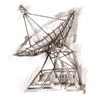 |
Astronomers use various types of
equipment based on the portion of the
E-M Band to be
observed.
Telescopes and
radio dishes are used from
the surface of the
Earth to study visible light, near
infrared light, and
radio waves. |
Attached to these
telescopes are various tools
like special made
CCD cameras, a wide variety of
filters, photometers and
spectrometers. These
various instruments are designed to record what we
normally cannot see with our eyes.
Other specialized instruments are also finding
their way into main stream astronomy, like
neutrino
detectors deep underground and gravity wave
detectors.
The following sections will look into the more
common pieces of equipment used today to gather
valuable data.
Back to Top |

